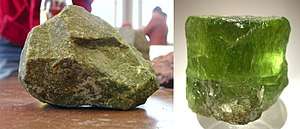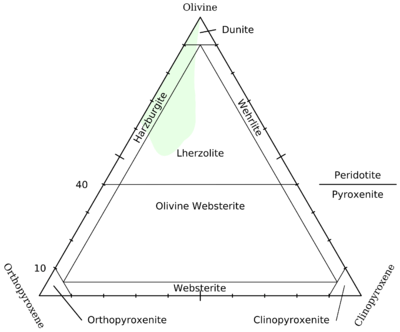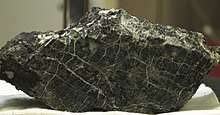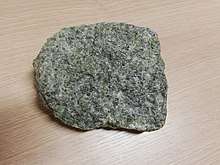Peridotite
Peridotite is a dense, coarse-grained igneous rock consisting mostly of the minerals olivine and pyroxene. Peridotite is ultramafic, as the rock contains less than 45% silica. It is high in magnesium (Mg2+), reflecting the high proportions of magnesium-rich olivine, with appreciable iron. Peridotite is derived from the Earth's mantle, either as solid blocks and fragments, or as crystals accumulated from magmas that formed in the mantle. The compositions of peridotites from these layered igneous complexes vary widely, reflecting the relative proportions of pyroxenes, chromite, plagioclase, and amphibole.
| Igneous rock | |
 Typical peridotite sample (dunite, left) and large olivine crystal (right) | |
| Composition | |
|---|---|
| olivine, pyroxene |
Peridotite is the dominant rock of the upper part of the Earth's mantle. The compositions of peridotite nodules found in certain basalts and diamond pipes (kimberlites) are of special interest, because they provide samples of the Earth's mantle brought up from depths ranging from about 30 km to 200 km or more. Some of the nodules preserve isotope ratios of osmium and other elements that record processes that occurred when the earth was formed, and so they are of special interest to paleogeologists because they provide clues to the early composition of the Earth's mantle and the complexities of the processes that occurred.
The word peridotite comes from the gemstone peridot, which consists of pale green olivine.[1] Classic peridotite is bright green with some specks of black, although most hand samples tend to be darker green. Peridotitic outcrops typically range from earthy bright yellow to dark green in color; this is because olivine is easily weathered to iddingsite. While green and yellow are the most common colors, peridotitic rocks may exhibit a wide range of colors such as blue, brown, and red.
Types of peridotite

- Dunite: more than 90% olivine, typically with Mg/Fe ratio of about 9:1.
- Wehrlite: mostly composed of olivine plus clinopyroxene.
- Harzburgite: mostly composed of olivine plus orthopyroxene, and relatively low proportions of basaltic ingredients (because garnet and clinopyroxene are minor).
- Lherzolite: most common form of peridotite, mostly composed of olivine, orthopyroxene (commonly enstatite), and clinopyroxene (diopside), and have relatively high proportions of basaltic ingredients (garnet and clinopyroxene). Partial fusion of lherzolite and extraction of the melt fraction can leave a solid residue of harzburgite.
Composition
Olivine is a magnesium orthosilicate containing some iron with the variable formula (Mg,Fe)2SiO4; the pyroxenes are chain silicates having the variable formula (Ca,Na,FeII,Mg)(Cr,Al,FeIII,Mg,Mn,Ti,V)Si2O6 comprising a large number of different minerals.
Magnesium-rich olivine forms a large proportion of peridotite, and so magnesium content is high. Layered igneous complexes have much more varied compositions, depending on the fractions of pyroxenes, chromite, plagioclase, and amphibole. Minor minerals and mineral groups in peridotite include plagioclase, spinel (commonly the mineral chromite), garnet (especially the mineral pyrope), amphibole, and phlogopite. In peridotite, plagioclase is stable at relatively low pressures (crustal depths), aluminous spinel at higher pressures (to depths of 60 km or so), and garnet at yet higher pressures.
Pyroxenites are related ultramafic rocks, which are composed largely of orthopyroxene and/or clinopyroxene; minerals that may be present in lesser abundance include olivine, garnet, plagioclase, amphibole, and spinel.
Distribution and location

Peridotite is the dominant rock of the Earth's mantle above a depth of about 400 km; below that depth, olivine is converted to the higher-pressure mineral wadsleyite. Oceanic plates consist of up to about 100 km of peridotite covered by a thin crust; the crust, commonly about 6 km thick, consists of basalt, gabbro, and minor sediments. The peridotite below the ocean crust, "abyssal peridotite," is found on the walls of rifts in the deep sea floor.[3] Oceanic plates are usually subducted back into the mantle in subduction zones. However, pieces can be emplaced into or overthrust on continental crust by a process called obduction, rather than carried down into the mantle; the emplacement may occur during orogenies, as during collisions of one continent with another or with an island arc. The pieces of oceanic plates emplaced within continental crust are referred to as ophiolites; typical ophiolites consist mostly of peridotite plus associated rocks such as gabbro, pillow basalt, diabase sill-and-dike complexes, and red chert. Other masses of peridotite have been emplaced into mountain belts as solid masses but do not appear to be related to ophiolites, and they have been called "orogenic peridotite massifs" and "alpine peridotites." Peridotites also occur as fragments (xenoliths) carried up by magmas from the mantle. Among the rocks that commonly include peridotite xenoliths are basalt and kimberlite. Certain volcanic rocks, sometimes called komatiites, are so rich in olivine and pyroxene that they also can be termed peridotite. Small pieces of peridotite have even been found in lunar breccias.
The rocks of the peridotite family are uncommon at the surface and are highly unstable, because olivine reacts quickly with water at typical temperatures of the upper crust and at the Earth's surface. Many, if not most, surface outcrops have been at least partly altered to serpentinite, a process in which the pyroxenes and olivines are converted to green serpentine. This hydration reaction involves considerable increase in volume with concurrent deformation of the original textures. Serpentinites are mechanically weak and so flow readily within the earth. Distinctive plant communities grow in soils developed on serpentinite, because of the unusual composition of the underlying rock. One mineral in the serpentine group, chrysotile, is a type of asbestos.
Morphology and texture
Peridotites can take on a massive form or may be in layers. Layered peridotites may form the base layers of gabbroic complexes. Even though some layered peridotites appear to have no associated gabbro, they probably once were part of such a complex. Three main textures are found in peridotites: the first are well formed crystals of olivine surrounded by other minerals. These olivine crystals probably settled out of the magma first. Another texture is equal sized crystals with straight grain boundaries intersecting at 120°. This may result when slow cooling allowed recrystallization to minimize surface energy. A third texture has long crystals with ragged curvilinear boundaries, a result of internal deformation.

Many peridotite occurrences have characteristic textures. For example, peridotites with well-formed olivine crystals occur mainly as layers in gabbroic complexes. "Alpine" peridotites generally have irregular crystals that occur as more or less serpentinized lenses bounded by faults in belts of folded mountains such as the Alpines, the Pacific coast ranges, and in the Appalachian piedmont. Peridotite nodules with irregular equigranular textures are often found in alkaline basalts and in kimberlite pipes. Some peridotites, rich in amphibole, have a concentric layered structure and form parts of plutons called Alaskan-type zoned ultramafic complexes.
Origin
Peridotites have two primary modes of origin, as mantle rocks formed during the accretion and differentiation of the Earth, or as cumulate rocks formed by precipitation of olivine ± pyroxenes from basaltic or ultramafic magmas; these magmas are ultimately derived from the upper mantle by partial melting of mantle peridotites.
Mantle peridotites are sampled as alpine-type massifs in collisional mountain ranges or as xenoliths in basalt or kimberlite or as abyssal peridotites (sampled from ocean floor). In all cases these rocks are pyrometamorphic (that is, metamorphosed in the presence of molten rock) and represent either fertile mantle (lherzolite) or partially depleted mantle (harzburgite, dunite). Alpine peridotites may be either of the ophiolite association and representing the uppermost mantle below ocean basins, or masses of subcontinental mantle emplaced along thrust faults in mountain belts.
Layered peridotites are igneous sediments and form by mechanical accumulation of dense olivine crystals. Some peridotite forms by precipitation and collection of cumulate olivine and pyroxene from mantle-derived magmas, such as those of basalt composition. Peridotites associated with Alaskan-type ultramafic complexes are cumulates that probably formed in the root zones of volcanoes. Cumulate peridotites are also formed in komatiite lava flows.
Basaltic magma is formed from lherzolites in the mantle. Once the magma moves out it leaves harzburgites behind in the mantle. However early formed crystals in basaltic magma can also form harzburgite within the mantle.
Associated rocks
Komatiites are high temperature partial melts of peridotite.
Eclogite, a rock similar to basalt in composition, is composed primarily of sodic clinopyroxene and garnet. Eclogite is associated with peridotite in some xenolith occurrences; it also occurs with peridotite in rocks metamorphosed at high pressures during processes related to subduction.
Economic geology
According to a 2008 study,[4] peridotite may potentially be used in a low-cost, safe and permanent method of capturing and storing atmospheric CO2 as part of climate change-related greenhouse gas sequestration. It was already known that peridotite reacts with CO2 to form a solid carbonate-like limestone or marble mineral; and the study concluded that this process can be sped up a million times or more by simple drilling and hydraulic fracturing to allow injection of the CO2 into the subsurface peridotite formation.
Peridotite is named for the gemstone peridot, a glassy green gem mined in Asia and Arizona (Peridot Cove). Some peridotite is mined for ornamental stone.
Peridotite that has been hydrated at low temperatures forms serpentinite, which may include chrysotile asbestos (a form of serpentine) and talc.
Layered intrusions with cumulate peridotite are typically associated with sulfide or chromite ores. Sulfides associated with peridotites form nickel ores and platinoid metals; most of the platinum used in the world today is mined from the Bushveld Igneous Complex in South Africa and the Great Dyke of Zimbabwe. The chromite bands found in peridotites are the world's major source of chromium.
References
- Collins Australian Dictionary, 7th edition
- Deep Carbon Observatory (2019). Deep Carbon Observatory: A Decade of Discovery. Washington, DC. doi:10.17863/CAM.44064. Retrieved 13 December 2019.
- Dick, H. J. B. (1989). "Abyssal peridotites, very slow spreading ridges and ocean ridge magmatism". Geological Society, London, Special Publications. 42 (1): 71–105. doi:10.1144/GSL.SP.1989.042.01.06.
- Kelemen, P. B.; Matter, J. (2008). "In situ carbonation of peridotite for CO2 storage". Proceedings of the National Academy of Sciences. 105 (45): 17295–17300. doi:10.1073/pnas.0805794105. Lay summary – Science Daily (November 6, 2008).
Further reading
- Anderson, A. T., Jr. (2019). "Peridotite". AccessScience. McGraw-Hill. doi:10.1036/1097-8542.498300.
- Harvey Blatt and Robert J. Tracy, 1996, Petrology: Igneous, Sedimentary and Metamorphic, 2nd ed., Freeman, ISBN 0-7167-2438-3
- J.-L. Bodinier and M. Godard, 2004, Orogenic, Ophiolitic, and Abyssal Peridotites, in The Mantle and Core (ed. R. W. Carlson), Treatise on Geochemistry v. 2, Elsevier-Pergamon, Oxford ISBN 0-08-043751-6
External links
![]()